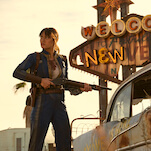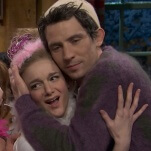Sarah W. Searle announces her new coming-of-age graphic novel Thimble
Sarah Winifred Searle has been steadily building a reputation for herself as a cartoonist, thanks to her talent for character-driven stories with rich emotion and gently evocative artwork. She’s grown with each new project, whether it’s longer stories like Rosy Press’ Ruined (written by Sarah Vaughn) or short comics like the recent “Fatness, Femininity And The Media We Deserve” for The Nib, and Searle is applying her skills to a new graphic novel coming from Lerner Publishing’s Graphic Universe in fall 2019: Thimble. Telling the story of a 12-year-old girl, Harriet Flores, who moves to Chicago from rural Indiana, Thimble has been on Searle’s mind for half a decade, and she gave The A.V. Club first details on why she wants to bring Harriet’s story to the page and how she’s pushing herself with this latest endeavor.
“Thimble has evolved a lot since I began writing it over five years ago,” said Searle. “It began pretty straightforwardly as a comic about a girl in a strange old house, but quickly turned into an outlet for me to process some complicated feelings and relationships in my own life. I’m fascinated by how we perceive the world, and how concepts like history and truth are so subjective depending on who’s experiencing and curating those narratives. Stories have such great power over us as human beings, even in fiction. That power is wonderful and fascinating and scary all at the same time, and that’s what Harriet learns in this book.”
History plays a big role in Thimble, which isn’t a surprise given Searle’s previous work on comic-book period pieces. The main action takes place in 1996, and the landlord of Harriet’s building, Pearl, opens the door for Searle to venture even further in the past. “Readers who expect historical comics from me won’t be disappointed,” said Searle. “[Thimble’s] a period piece in itself, now that 1996 is a whole 20 years ago, but it also touches on Pearl’s past, which deepens the scope of the story to the 1950s during the polio epidemic.”
Searle is pulling heavily from her own youth to inform Harriet’s story, and she’s taking this opportunity to offer the kind of representation she wishes she saw growing up, particularly in terms of same-sex romantic relationships with Harriet’s crush on another girl. “I drew on my own experiences as far as Harriet’s crush,” said Searle, “because I truly believe that if I saw another kid feel that way in the media I consumed at that age, I would have grown up a lot more open about and comfortable with those feelings. I really hope my book makes it into the hands of even just a few kids who need to see reflections of themselves like that.”












![HBO teases new Euphoria, Larry David, and much more in 2026 sizzle reel [Updated]](https://img.pastemagazine.com/wp-content/avuploads/2025/12/12100344/MixCollage-12-Dec-2025-09-56-AM-9137.jpg)



























